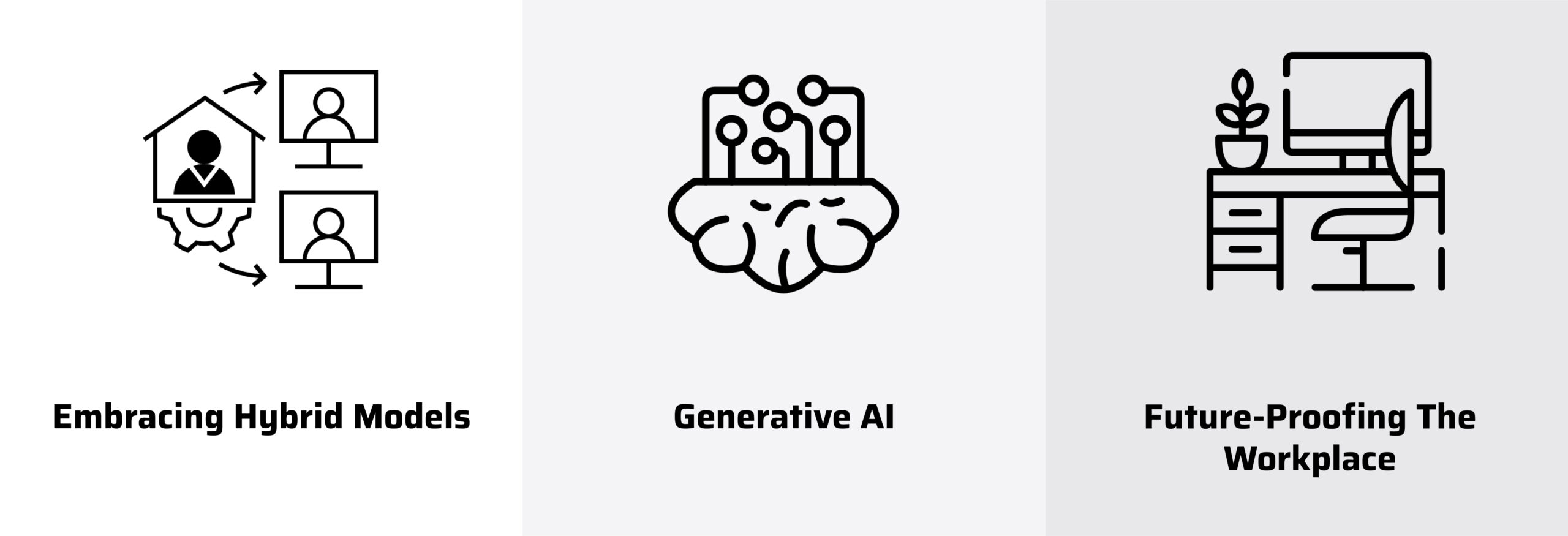The Importance of Continuous Improvement and Future Trends in ITSM
To stay ahead in this dynamic industry, businesses must embrace continuous improvement and stay abreast of emerging trends that shape the future of IT Service Management (ITSM). Here, we will explore the latest trends and strategies to drive continuous improvement in ITSM, paving the way for enhanced productivity and success.
Embracing Automation for Increased Efficiency
Automation has emerged as a game-changer in ITSM, enabling organisations to streamline processes, reduce manual effort, and improve service delivery. By automating routine tasks, such as incident resolution, change management, and service requests, businesses can enhance efficiency, reduce human errors, and allocate resources to more strategic initiatives. Additionally, leveraging technologies like artificial intelligence (AI) and machine learning (ML) can enable intelligent automation, empowering ITSM teams to provide faster and more accurate solutions.
Adopting Agile and DevOps Practices
Agile and DevOps methodologies have revolutionised ITSM by promoting collaboration, continuous integration, and rapid deployment of software and services. By adopting agile practices, ITSM teams can enhance flexibility, respond swiftly to changing business needs, and deliver incremental value. Integrating DevOps principles into ITSM fosters a culture of collaboration between development and operations teams, resulting in faster problem resolution, improved service quality, and accelerated time-to-market for new solutions.
Harnessing the Power of Analytics and Data
Data is a valuable asset in ITSM, and leveraging analytics and data can provide invaluable insights to drive informed decision-making and proactive service management. By analysing vast amounts of data generated from various sources, including service tickets, user feedback, and system logs, organisations can identify patterns, anticipate issues, and make data-driven improvements. Additionally, predictive analytics can help forecast future demand, optimise resource allocation, and prevent potential disruptions.
Enhancing User Experience with Self-Service Capabilities
Empowering users with self-service capabilities has become increasingly important in ITSM. By providing user-friendly portals and knowledge bases, businesses enable users to access information, request services, and troubleshoot common issues independently. Self-service not only improves user satisfaction but also reduces the workload on IT support teams, allowing them to focus on more complex and critical tasks. Furthermore, incorporating virtual agents and chatbots can provide personalised assistance, enhancing the overall user experience.
Ensuring Cybersecurity and Data Privacy
As the digital landscape expands, the importance of cybersecurity and data privacy in ITSM cannot be overstated. Organisations must prioritise robust security measures to safeguard sensitive data, protect against cyber threats, and comply with regulatory requirements. Implementing multi-factor authentication, encryption techniques, and comprehensive security frameworks is crucial to maintain the integrity and confidentiality of IT services and user information.
Embracing ITSM Frameworks and Best Practices
ITSM frameworks and best practices provide a structured approach to managing IT services effectively. Frameworks such as ITIL (Information Technology Infrastructure Library) offer guidelines and processes that organisations can adopt to align their ITSM practices with industry standards. By embracing these frameworks and continuously refining their implementation, businesses can ensure consistent service delivery, efficient incident management, and improved overall IT governance.
Conclusion
Continuous improvement and staying ahead of future trends are essential in the ever-evolving field of ITSM. By embracing automation, adopting agile and DevOps practices, harnessing analytics and big data, enhancing user experience, prioritising cybersecurity, and adhering to ITSM frameworks, businesses can drive efficiency, deliver exceptional services, and maintain a competitive edge. As technology advances and customer expectations evolve, embracing these trends and evolving alongside them will be key to success in the dynamic world of IT service management.
Looking for an ITSM Solution for your Business? We can help.
Let's chat
Exploring the Zoho Suite - A Guide to Zoho's Integrated Apps
Are you searching for a comprehensive suite of business tools that can truly revolutionise the way you operate? Look no further than Zoho! In this guide, we’ll delve into the expansive world of Zoho, where it’s not just about applications but a full-fledged operating system for your business needs.
With Zoho, you can seamlessly integrate various functions of your business, from email management to HR, marketing, and CRM, all in one platform. It’s more than just software; it’s a transformative solution that can eliminate multiple siloed apps and licensing whilst providing one uniform platform with more than 55 deeply integrated apps on its platform. That’s precisely why it’s often referred to as “An operating system for your business”.
What is Zoho?
Zoho stands as a cloud-based software suite offering a comprehensive array of applications tailored to streamline diverse business operations. Established in 1996, Zoho has evolved into a formidable force in the Software as a Service (SaaS) arena, catering to millions of users globally.
Its expansive reach spans across various continents, with offices in multiple countries, including China, Singapore, and Japan. As of 2022, Zoho Corporation boasts over 80 million users, with a steady influx of approximately 5 million new users annually. This remarkable growth and global presence make Zoho an undeniably attractive option for businesses seeking efficient solutions to their operational needs.
Benefits of Using Zoho
All-in-One Solution
One of the primary advantages of Zoho is its all-in-one approach. Instead of piecing together multiple software solutions from different providers, businesses can rely on Zoho for their various needs, saving time and resources in the process.
Scalability
Whether you’re a small startup or a large enterprise, Zoho scales to accommodate your business’s growth. With flexible pricing plans and a wide range of applications to choose from, Zoho can adapt to your evolving needs as your business expands.
User-Friendly Interface
Zoho’s intuitive interface makes it easy for users to get started with its suite of applications. With minimal training required, businesses can onboard employees quickly and ensure maximum productivity from day one.
Integration Capabilities
Zoho integrates seamlessly with other popular business tools, allowing for greater efficiency and productivity. Whether you’re synchronising data between applications or automating workflows, Zoho’s integration capabilities make it a versatile choice for businesses of all kinds.
The Zoho Suite: A Comprehensive Overview
Zoho CRM
At the heart of the Zoho suite lies Zoho CRM, a robust customer relationship management solution. With Zoho CRM, businesses can manage leads, track sales activities, and nurture customer relationships effectively. Its intuitive interface and powerful features make it a go-to choice for businesses looking to streamline their sales processes.
Zoho Projects
For project management needs, Zoho Projects is the tool of choice. Whether you’re overseeing a small team or managing complex projects with multiple stakeholders, Zoho Projects offers the functionality you need to stay organised and on track. From task management to time tracking and collaboration tools, Zoho Projects has you covered.
Zoho Books
Managing finances is a breeze with Zoho Books. This cloud-based accounting software simplifies tasks such as invoicing, expense tracking, and inventory management. With Zoho Books, you can gain valuable insights into your business’s financial health and make informed decisions to drive growth.
Zoho Mail
Communication is key in any business, and Zoho Mail ensures seamless collaboration among team members. With features such as email hosting, calendar integration, and robust security measures, Zoho Mail provides a reliable solution for businesses looking to streamline their communication workflows.
Zoho Analytics
Data-driven decision-making is made easy with Zoho Analytics. This powerful business intelligence tool allows you to visualise and analyse data from various sources, enabling you to uncover insights that drive business growth. With customisable dashboards and advanced analytics capabilities, Zoho Analytics empowers businesses to make informed decisions quickly.
Zoho Desk
Delivering exceptional customer support is effortless with Zoho Desk. This help desk software enables businesses to manage customer inquiries across multiple channels, ensuring prompt and personalised responses. With features such as ticket management, knowledge base, and automation tools, Zoho Desk helps businesses provide top-notch support to their customers.
Beyond these key apps, Zoho extends its capabilities to cover all other vital aspects of business operations, including sites, marketing, social engagement, e-commerce, invoicing, and subscriptions.
Conclusion
In conclusion, Zoho offers a comprehensive suite of applications designed to streamline various aspects of business operations. From CRM and project management to accounting and customer support, Zoho has you covered. With its user-friendly interface, scalability, and integration capabilities, Zoho is the ideal choice for businesses looking to boost productivity and drive growth.
So why wait? Explore the Zoho suite today and take your business to new heights!
Let's chat
Modernise Your Legacy Systems with Outsystems: 3 Strategies for Success.
Businesses are under constant pressure to adapt and innovate to stay ahead. However, many organisations are held back by their legacy systems, which struggle to keep pace with modern demands. Fortunately, there’s a solution: OutSystems. As an OutSystems partner, 9X5 is committed to helping businesses transform their existing IT infrastructure into modern, efficient technology. In this article, we’ll explore three powerful strategies for modernising legacy systems using OutSystems’ high-performance low-code platform.
The Challenge of Legacy Systems
Legacy systems, including outdated technologies like COBOL, continue to play a vital role in many organisations, performing core functions reliably but lacking the flexibility and agility required to meet today’s business needs. The traditional approach of ripping and replacing these systems is costly, time-consuming, and fraught with risk. Moreover, IT and business teams often struggle to align their priorities, leading to frustration and inefficiency.
Three Strategies for Modernisation
OutSystems offers three innovative strategies for modernising legacy systems:
1. Extend
Think of your enterprise IT systems as a house. Extending is akin to adding a new room or window to accommodate changing needs. With OutSystems, you can quickly add new capabilities and customer journeys without altering the core system architecture. Leveraging prebuilt connectors to common enterprise systems like SAP and Salesforce, you can seamlessly integrate data and build custom views tailored to your business requirements. This approach enables rapid innovation without incurring technical debt.
2. Refactor
Refactoring involves re-envisioning legacy systems one component at a time, gradually transforming the entire architecture into a modern, decoupled environment. Like rearranging the rooms of a house, refactoring allows organisations to address urgent needs while minimising disruption. With OutSystems, enterprises can refactor specific functions, integrating them with the rest of the ecosystem to facilitate interoperability and scalability. By eliminating technical debt and unexpected dependencies, this approach sets the stage for long-term success.
3. Re-build
When legacy systems reach the end of their life or no longer meet business requirements, rebuilding becomes necessary. OutSystems empowers organisations to rebuild from the ground up, creating purpose-built, cloud-native solutions tailored to their exact needs. By tapping into original data sources and leveraging high-performance low-code development, companies can accelerate the transition to a modern architecture while minimising downtime and disruption. This approach ensures seamless integration with existing systems, enabling a smooth transition to the new platform.
Conclusion
Modernising legacy systems is essential for businesses looking to thrive in today’s digital economy. With OutSystems, organisations can choose from three powerful strategies—extend, refactor, or rebuild—to transform their IT infrastructure at their own pace. Whether augmenting existing systems, re-envisioning legacy components, or building from scratch, OutSystems provides the tools and expertise needed to drive innovation and accelerate growth. Partner with 9X5 and embark on your digital transformation journey today.
Ready to modernise your legacy systems with OutSystems? Contact us today to learn more about how companies around the world have successfully transformed their IT infrastructure using our high-performance low-code platform. Unlock the power of innovation and drive accelerated growth with OutSystems and 9X5.
Let's chat
The Benefits of Bringing in a Partner for IT Cost Reduction Analysis
Cost optimisation is a top priority for most Chief Information Officers (CIOs), notes Ola Chowning, a partner at the technology research and advisory firm ISG. According to her, organisations are increasingly cautious about undertaking extensive transformations unless they are rooted in agility—meaning smaller expenditures leading to quicker outcomes—and, to some extent, self-funding.
This pragmatic approach anticipates that day-to-day IT costs will either remain stable or decrease, emphasising the need for a continually optimised cost basis as businesses progress in their digital transformation journeys and modernise their IT capabilities.
Whilst It may seem counterintuitive to bring in outside consultants to help reduce costs, with your technology team focused on delivering a seamless experience for staff and customers and the attachment that existing staff may have to teams, technologies and programs, a consulting partner that understands your business and digital drivers offers significant benefit.
Understanding Cost Reduction Analysis in ICT
Cost reduction analysis in ICT involves comprehensively examining the organisation’s technology-related expenditures to identify areas where efficiency can be improved and costs can be minimised. This process goes beyond simply slashing budgets; it aims to streamline operations, enhance productivity, and align technology investments with business goals.
Key Steps in Cost Reduction Analysis
Inventory and Assessment:
Begin by taking stock of all ICT assets, services, and associated costs. This includes hardware, software licenses, subscriptions, maintenance, and personnel-related expenses. A thorough assessment provides a baseline for understanding the current state of ICT expenditures.
Identifying Inefficiencies:
Analyse the usage and performance of existing technologies. Identify redundant or underutilised resources, obsolete software, and any inefficiencies in current processes. Pinpointing these areas allows for targeted cost-cutting measures.
Benchmarking and Market Analysis:
Compare your organisation’s ICT costs against industry benchmarks and conduct a market analysis to ensure that you are getting the best value for your investments. This step can reveal opportunities for negotiation with vendors and potential savings.
Technology Rationalisation:
Evaluate the need for each technology component and eliminate redundancies. Consolidate services to reduce licensing fees, maintenance costs, and overall complexity. Examine closely where M&A activity or shadow IT has occurred in the past, as these areas frequently have costly double-ups or unused costly items.
Optimising Infrastructure:
Assess the organisation’s infrastructure, including servers, storage, and network resources. Virtualisation, cloud migration, and infrastructure optimisation can save significant costs while improving scalability and flexibility.
The Role of Digital Consulting Partners
Engaging a digital consulting partner such as 9X5 greatly enhances the effectiveness of cost reduction analysis in ICT. Here’s how:
Expertise and Experience:
At 9X5, our team bring a wealth of expertise and experience in ICT and has a deep understanding of industry best practices, emerging technologies, and proven strategies for optimising costs without compromising performance.
Independent Evaluation:
An external perspective helps in objectively evaluating your organisation’s ICT landscape. We identify blind spots, uncover hidden costs, and offer unbiased recommendations.
Customised Solutions:
9X5’s consultants tailor cost-reduction strategies to your organisation’s specific needs and goals. They provide customised solutions that align with your business objectives, ensuring that the cost-cutting measures implemented support overall growth and sustainability.
Change Management Support:
Implementing cost-reduction measures often involves changes in processes and We provide guidance and support for effective change management, ensuring a smooth transition and minimal disruption to daily operations.
Conclusion
In the dynamic world of ICT, continuous cost reduction analysis is essential for organisations aiming to stay competitive while optimising their budgets. A digital consulting partner brings invaluable insights and a strategic approach to this process, helping organisations cut costs and enhance their overall ICT efficiency and performance. By embracing cost reduction analysis with the support of a digital consulting partner, organisations can pave the way for sustainable growth and innovation in the digital age.
Maximising Cost Savings with Data Analytics
Organisations are constantly seeking innovative ways to enhance efficiency and cut costs. One powerful tool that has emerged as a game-changer is data analytics. In this article, we’ll delve into the profound impact of utilising data analytics for achieving substantial cost savings.
The Strategic Power of Data Analytics
In the digital age, businesses are drowning in a sea of data. However, the true potential lies in the ability to extract meaningful insights. Enter data analytics – a strategic approach that transforms raw data into actionable intelligence. By harnessing the power of analytics, organisations can identify patterns, trends, and outliers that hold the key to significant cost-saving opportunities.
Precision Decision-Making
Data-driven decision-making is the cornerstone of a cost-efficient operation. Analytics empowers businesses to make precise, informed choices based on real-time data. This not only streamlines processes but also minimises the risk of costly errors. From inventory management to resource allocation, every decision becomes a calculated step towards financial optimisation.
Predictive Analytics for Future-Proofing Finances
Anticipating future trends and challenges is a vital aspect of cost management. Predictive analytics, a subset of data analytics, enables businesses to forecast future expenses accurately. By identifying potential cost drivers, organisations can proactively implement strategies to mitigate risks, ensuring long-term financial stability.
Operational Efficiency Unleashed
Data analytics serves as a beacon for operational efficiency. Through detailed analysis, businesses can identify bottlenecks, redundancies, and inefficiencies in their processes. This newfound clarity allows for targeted interventions, eliminating wasteful practices and optimising resource utilisation – a direct route to substantial cost savings.
Cost Savings in Customer Engagement
Understanding customer behaviour is paramount in a competitive market. Data analytics provides insights into customer preferences and purchasing patterns. By tailoring marketing strategies and product offerings to align with these insights, businesses can maximise the effectiveness of their campaigns, thereby reducing unnecessary marketing expenditures.
The Bottom Line: Tangible Cost Reductions
In conclusion, the integration of data analytics into business operations goes beyond mere trendiness – it’s a strategic necessity. From informed decision-making to operational streamlining, the impact on cost savings is undeniable. Embrace the power of data analytics, and witness not just a technological revolution, but a tangible boost to your bottom line.
Interested in the cost-saving capabilities of Data Analytics? Contact us today to see how we can help.
Navigating Digital Transformation in Local Governments: A Data Analytics Approach
In an era marked by unprecedented technological advancements, local governments find themselves at the crossroads of embracing digital transformation or lagging in the wake of progress. The potential rewards for those who choose the former are substantial, including improved personalisation, effective identity management, seamless integration of front, middle, and back-office functions, and the cultivation of a more adaptable workforce. To unlock these benefits, local governments must harness the power of data analytics—a key driver in navigating the complexities of digital transformation.
Embracing Customer-Centric Digital Transformation
At the heart of successful digital transformation in local governments lies a customer-centric approach. The objective is clear: consistently design and implement an operating model that genuinely caters to the needs of the constituents. This approach goes beyond merely automating existing processes; it involves a fundamental shift toward providing digital services and capabilities that encompass processes, systems, connections, and data. Such optimisation isn’t just a technological upgrade; it’s a strategic imperative aimed at enhancing how government functions for each constituent and stakeholder.
The Role of Data Analytics in Optimising Local Government Operations
Data analytics serves as the linchpin in the successful execution of digital transformation initiatives within local governments. It involves the systematic use of data to uncover actionable insights, streamline processes, and enhance decision-making capabilities. Here’s how local governments can leverage data analytics at each stage of their digital transformation journey:
1. Data-Driven Decision Making:
Informed decision-making is the cornerstone of effective governance. By leveraging data analytics, local governments can sift through vast datasets to extract meaningful insights. Whether it’s optimising resource allocation, identifying areas for improvement, or predicting future trends, data-driven decision-making empowers local authorities to make informed choices that resonate with the needs of their communities.
2. Enhanced Service Delivery:
Digital transformation should translate into tangible improvements in service delivery. With data analytics, local governments can gain a deep understanding of citizen preferences and behaviours. This insight enables the tailoring of public services to meet the specific needs of different demographics, fostering a sense of inclusivity and responsiveness.
3. Predictive Analytics for Resource Optimisation:
Local governments often face resource constraints. Predictive analytics can help in forecasting demand for services, allowing for proactive resource allocation. This not only enhances operational efficiency but also ensures that essential services are delivered on time, contributing to overall citizen satisfaction.
4. Cybersecurity and Data Protection:
With the increasing digitisation of government services, cybersecurity becomes paramount. Data analytics can play a crucial role in identifying and mitigating potential cyber threats. By continuously monitoring and analysing network activities, local governments can ensure the security and integrity of sensitive information.
Overcoming Challenges on the Road to Digital Transformation
While the benefits of data analytics in local government digital transformation are evident, the journey is not without challenges. From data privacy concerns to the need for upskilling the existing workforce, local authorities must navigate these obstacles strategically. Here’s how:
1. Addressing Data Privacy Concerns:
As local governments amass vast amounts of data, ensuring its security and privacy becomes a top priority. Implementing robust data protection measures and complying with relevant regulations not only safeguards citizens’ information but also builds trust in the digital services provided.
2. Upskilling the Workforce:
The success of digital transformation initiatives heavily relies on the competence of the workforce. Local governments must invest in upskilling programs to ensure that employees have the necessary digital literacy and technical skills to navigate the evolving digital landscape.
Paving the Way for Future-Ready Local Governments
In conclusion, local governments stand at the cusp of a transformative era, with data analytics catalysing meaningful change. By embracing a customer-centric approach and leveraging the power of data analytics, local authorities can not only enhance operational efficiency but also deliver public services that truly resonate with the diverse needs of their communities. As the digital landscape continues to evolve, local governments that invest in data-driven decision-making and prioritise cybersecurity will emerge as leaders in the era of smart, responsive governance.
To find out more, contact us today to see our Data Analytics Capabilities.
Gartner's Tech Trends 2024: A Comprehensive Review for Australian Professional Services Companies
Gartner’s Top 10 Strategic Technology Trends for 2024 beckon professional services companies in Australia to navigate the intricate landscape of AI-driven progress. As we dissect these trends, let’s not merely acknowledge them but scrutinise their nuances, exploring fresh perspectives to extract maximum value for the professional services sector Down Under.
Theme 1: Safeguarding Investments in the Tech Realm
Gartner urges businesses to tread cautiously, steering away from uncontrolled experimentation, and instead, adopt a measured, realistic, and forward-looking approach. The call to calculate Return on Investment (ROI) from the project’s inception resonates strongly, reminding professional services firms in Australia that strategic planning is key. The trends underpinning this theme, including AI Trust, Risk and Security Management (AI TRiSM), Continuous Threat Exposure Management (CTEM), Industry Cloud Platforms, Sustainable Technology, and Democratised Generative AI, demand not just attention but proactive adaptation.
The projection that Generative AI will overhaul 70% of design and development efforts by 2026 raises the stakes. It’s not merely about protection but about staking a claim in the future of digital creation.
Theme 2: Rise of the Builders – Nurturing Creativity
Gartner introduces the concept of ‘builders,’ urging professional services firms to tap into the creative potential of diverse communities. Beyond just adopting technology, the emphasis lies on creating roadmaps that empower non-specialists to contribute meaningfully. The trends encapsulating this theme – Platform Engineering, AI-Augmented Development, Industry Cloud Platforms, Intelligent Applications, Sustainable Technology, and Democratised Generative AI – herald an era where intelligent app and solution builders redefine the industry.
The prediction that 80% of CIOs will link performance metrics to sustainability by 2027 is a call for alignment with environmental responsibility. For Australian professional services companies, this is not just about tech innovation but about contributing to a sustainable future.
Theme 3: Delivering Value – A Paramount Pursuit
Delivering value lies at the core of professional services, and Gartner’s trends echo this sentiment. Beyond meeting stakeholder expectations, the call is to be agile in responding to customer demands, especially from algorithm-based customers. The trends supporting this theme – Machine Customers, Augmented Connected Workforce, Intelligent Applications, Sustainable Technology, and Democratised Generative AI – outline a pathway for professional services companies to stay ahead in an evolving digital landscape.
As the influence of algorithm-based customers expands, it’s not just a technological evolution; it’s a paradigm shift in customer dynamics. The emphasis on sustainability as a performance metric signals a transition from optional eco-friendly practices to imperative corporate responsibility.
Strategic Integration for Synergistic Outcomes:
Gartner underlines the interconnectivity of these trends, emphasising that their true power lies in their amalgamation. For Australian professional services companies, this isn’t just about adopting technologies in isolation; it’s about strategic integration. By combining these trends judiciously, firms can not only fortify their resilience but also harness data value, attract and retain talent, meet ESG goals, foster growth, and expedite digital business.
Conclusion:
In the review of Gartner’s Tech Trends 2024, Australian professional services companies are presented with an opportunity to transcend the ordinary. Beyond the technicalities, it’s about approaching these trends with discernment, viewing them not as a checklist but as a strategic arsenal. By embracing a multi-faceted perspective, companies can not only align with their leadership goals but also emerge as trailblazers in the dynamic landscape of professional services in Australia. The future beckons and Gartner’s trends are the compass pointing toward sustained success.
Unleashing the Power of Progressive Web Apps with OutSystems: A Comprehensive Guide
Mobile-friendly services have become a necessity, with over half of all internet traffic now originating from mobile devices. The question arises: must one invest in native iOS and Android development to cater to this ever-growing user base? The answer lies in Progressive Web Apps (PWAs), a revolutionary alternative that provides a native app-like experience without the complexities of native app development.
Understanding Progressive Web Apps
PWAs empower developers to deliver a seamless mobile app experience using standard web technologies such as HTML, CSS, and JavaScript. These apps are fast, capable of working offline, and even offer an “install” option, placing an app icon on the device’s home screen. But how do they achieve this?
PWA Fundamentals
At their core, PWAs are web applications that function in any browser. Leveraging the principle of progressive enhancement, PWAs gain additional functionalities, such as offline capabilities, when accessed through modern browsers. The key components that make PWAs stand out are:
Service Workers: These allow the execution of background JavaScript tasks directly on the device, enhancing responsiveness and reducing the need for constant server interactions.
Offline Cache: Service workers enable local data caching on the device, allowing PWAs to function without a network connection and sync with the server once back online.
App Manifest: Similar to native apps, PWAs come with an app manifest—a JSON file specifying the app’s icon, URL, and other relevant data, ensuring a user experience akin to traditional mobile apps.
Business Benefits of PWAs
PWAs offer a plethora of advantages, not just from a development perspective but also concerning user engagement and return on investment (ROI). Some of these include:
Discoverability: PWAs are indexed by search engines like regular websites, ranking higher and often appearing as snippet cards at the top of search results, thanks to Google’s mobile-first indexing.
Stickiness: Once installed, PWAs reside on the device’s home screen, providing easy access with a single tap, eliminating the need to open a browser first.
High Performance: Speed is critical for user adoption, and PWAs, loading and running faster as they work offline first, address this concern effectively.
Always Up to Date: PWAs automatically update over the air when the user connects to the server, ensuring users always have the latest version without manual intervention.
Responsiveness: PWAs adapt seamlessly to various screen sizes, providing a consistent user experience across devices.
Shareability: Easily shareable via links, PWAs eliminate the need for app marketplaces and lengthy downloads, promoting accessibility.
Native Device Capabilities: PWAs can utilise a device’s hardware features and support built-in payment systems like Apple Pay or Google Pay, offering a native app-like experience.
Advantages of PWAs
PWAs bring significant advantages to the table, including:
Built Using Existing Skills: Developed using familiar web technologies (HTML, CSS, JavaScript), PWAs leverage existing skills, accelerating development.
Cross-Platform Compatibility: Running on browsers, PWAs operate on any device with a modern browser, streamlining compatibility across multiple platforms.
Rapid Upgrading/Iterative Improvement: PWAs allow swift deployment of updates directly to users, eliminating the lag associated with app store approval processes.
Lower Costs: With a single code base applicable to all devices, development time is reduced compared to native app development, and there are no revenue-sharing costs with app stores.
Choosing PWAs makes sense for teams that struggle with resource allocation, prioritise speed, need a gradual adoption path for applications, aim to expand mobile presence, or face obstacles in delivering mobile applications.
OutSystems Accelerates PWA Development
OutSystems, a leading app development platform, streamlines the PWA development process. Key advantages include:
No Additional Knowledge Required: OutSystems automates the creation of PWAs, handling manifests and service workers seamlessly.
Single Code Base: Develop UI and front-end code once for both mobile apps and PWAs, engaging users across platforms without adapting code for each device.
Data Sync Framework: OutSystems facilitates seamless data synchronisation between PWAs and servers.
Streamlined Deployment: OutSystems automates the generation of resources needed for PWA deployment without developer intervention, achieving maximum scores on Google Lighthouse.
Modern Application Platform: Leveraging a visual, model-based development platform, OutSystems supports multi-disciplinary teams, ensuring apps meet business needs and performance requirements.
Automated Impact Analysis and Bug Checking: OutSystems utilises automation, AI, and analytics to remove guesswork, checking for errors and dependencies in real-time.
Embracing PWAs with OutSystems presents a compelling proposition for those seeking a cost-effective, efficient, and user-friendly solution for their mobile projects. Explore the world of PWAs and transform your mobile development journey today.
Need a PWA with OutSystems for your next project? See how 9X5 can help.
Boosting Operational Efficiency with High-Performance Low-Code Development
In an era where traditional strategies for driving growth are losing their efficacy, tech leaders are navigating a landscape marked by inflationary pressures and economic uncertainties. To stay ahead, they are turning to practical and affordable solutions that facilitate rapid adaptation and innovation at scale. One such solution gaining traction among Chief Information Officers (CIOs) is the adoption of high-performance low-code platforms, a strategy that not only fosters innovation but also maximises operational efficiency. This blog sheds light on why IT leaders are increasingly turning to high-performance low-code development and how your organisation can leverage this approach for similar gains.
The Shift in Approach
Gone are the days when companies could rely solely on price increases to fuel growth. The current landscape demands a more nuanced and adaptive approach. CIOs are at the forefront of this change, recognising the need for solutions that not only foster innovation but also enhance operational efficiency. High-performance low-code development emerges as a compelling choice in this scenario, offering a means to simultaneously innovate and achieve cost savings that can be reinvested in future app development.
Unlocking Efficiency with High-Performance Low-Code
The heart of the matter lies in the transformative capabilities of high-performance low-code development. Today, we will emphasise three key traits that enterprises should embrace to innovate faster. These traits not only set the foundation for innovation but also create an environment where operational efficiency is a natural by-product.
The first trait involves a strategic shift towards adaptability and agility. High-performance low-code platforms enable organisations to respond swiftly to changing market dynamics and customer needs. The inherent flexibility of these platforms allows for rapid prototyping and iteration, a crucial aspect in today’s fast-paced business environment.
Second, the current focus for most CIOs is on cost-effectiveness. CIOs are increasingly recognising the financial benefits of adopting high-performance low-code. Organisations can fund the development of future applications with the savings generated from current apps. This dual-purpose approach ensures that innovation is sustainable, with cost savings acting as a catalyst for future developments.
The third trait centres on scalability. High-performance low-code platforms are designed to scale seamlessly, accommodating the growing demands of an expanding business. This scalability is essential for organisations looking to innovate at scale without compromising operational efficiency.
Conclusion
In a landscape where traditional growth strategies fall short, tech leaders are turning towards innovative and cost-effective solutions to drive efficiency. High-performance low-code development stands out as a beacon in this transformative journey, enabling organisations to innovate at speed and scale while simultaneously maximising operational efficiency. The Operational Efficiency eBook serves as a valuable guide, offering insights and use cases that can empower your organisation to harness the full potential of high-performance low-code, unlocking a new era of innovation and efficiency.
Interested in using a high-performance low-code solution to build your next app? Contact us today to see how we can help.
Evolving Work Dynamics: Three Key Priorities for Future-Proofing the Workplace
Professional dynamics are constantly shifting, meaning the need to anticipate and adapt has never been more critical. Our latest article explores the three pivotal priorities shaping the professional landscape, from the embrace of hybrid models to the transformative power of generative AI. Discover the essence of future-proofing your workplace and stay ahead in the dynamic realm of work. Read on for a comprehensive insight into the leadership insights, future of work trends, and the strategic thinking required to thrive in the evolving professional landscape.
Embracing Hybrid Models: A Paradigm Shift in Work Dynamics
In the post-COVID professional landscape, embracing hybrid models emerges as a central focus. The conventional office-centric structure is transforming into a more flexible, adaptive model that seamlessly integrates both remote and in-person work. This paradigm shift ensures a harmonious blend where professionals can operate where they are most productive.
Expanding on this priority, organisations are increasingly recognising the significance of providing employees with the flexibility to choose their work environment. The emphasis is not only on accommodating diverse work styles but also on leveraging technology to foster collaboration and connectivity. Tools like video conferencing, project management software, and virtual collaboration platforms are becoming integral to maintaining a cohesive work culture despite physical distance.
As businesses navigate this shift, it becomes crucial to implement robust policies and technologies that support effective communication and collaboration in a hybrid setting. Moreover, fostering a culture of trust and accountability is essential to ensure that teams remain cohesive and engaged, regardless of their physical location.

The Impact of Generative AI: Reshaping Workflows and Possibilities
The advent of generative AI technologies like ChatGPT, Copilot, and AlphaCode represent a transformative force reshaping the professional landscape. The second critical priority revolves around comprehending and harnessing the impact of AI on workflows and possibilities. With generative AI expected to gain a ~30% share in the overall AI Market by 2025, integrating generative AI is pivotal for maintaining competitiveness in the evolving work environment.
Organisations need to invest in upskilling their workforce to navigate the integration of AI seamlessly. This involves providing training programs and resources to empower employees to work collaboratively with AI systems. Additionally, companies must carefully evaluate ethical considerations and ensure that the implementation of AI aligns with their values and principles.
As generative AI continues to evolve, staying informed about the latest advancements and possibilities is key. Embracing a culture of innovation and experimentation can help organisations stay at the forefront of technological developments, unlocking new avenues for efficiency and creativity.
Future-Proofing Your Workplace: A Strategic Imperative
With over 85% of organisations identifying increased adoption of new and frontier technologies as a trend most likely to drive transformation in their organisation, strategic thinking and long-term planning are vital components to ensure the resilience and sustainability of any professional environment. This encompasses not only embracing current trends but also anticipating and preparing for future shifts in the ever-changing work landscape.
To elaborate on this priority, organisations must foster a culture of adaptability and continuous learning. This involves encouraging employees to stay abreast of industry trends, acquire new skills, and embrace a mindset of lifelong learning. Creating a flexible organisational structure that can quickly adapt to technological advancements and market changes is essential for long-term success.
In conclusion, embracing hybrid models, understanding the impact of generative AI, and adopting a strategic approach to future-proofing are the three crucial priorities that define the future of work. Stay ahead by navigating these changes with foresight and adaptability.









